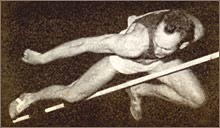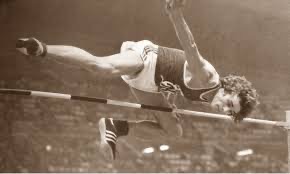Valery Brumel
- Dive Straddle Technique Part 1 (Thomas Zacharias)

- Dive Straddle Technique Part 2 (Thomas Zacharias)
- High Jump Straddle, extreme diving
- Analysis of Yaschenko’s Take Off & Dive Straddle
- High Jump Straddle: Spielvogel & Hopf
- High Jump - The Art of Straddle
- Historic Films (HJers) in Slow Motion
- First 7 Foot High Jump Ever
- Enzo Del Forno 1975, 2.226 M
- Russian Straddle Training Film (in Russian)
- Russian HJ Special Exercises (in Russian)
- Russian Tribute & Report on Brumel’s Career
- Brumel Jumping at Age 18
- Brumel Tribute
- Another Russian Tribute to Brumel
- Rare Slow Motion Footage of Brumel
- Brumel’s 7’5” record at Palo Alto
- Christian Schenk (GDR) 2.22 M Straddle 1990
- Ni Chin Chin 7’5” Jump 2.27 M
- Brumel’s Highest Jump of 7’ 5 3/4” or 2.28 M
- Pat Matzdorf Breaks Brumel’s Record- 7’6 “ or 2.29 M
- Vladimir Yashchenko - The Greatest Dive Straddler To Date
- Vladimir Yashchenko (Slow Motion)
- Vladimir Yashchenko - Best Straddle Sequences Ever
- Vladimir Yashchenko (Part 1) - Last King of the Straddle Technique
- Vladimir Yashchenko (Part 2) - Last King ofthe Straddle Technique
- Vladimir Yashchenko (Part 3) - Last King of the Straddle Technique
Vladimir Yashchenko

For Left Handed (or Right Take-off Foot) Jumpers:
- Swede Jumper Stig Pettersson at 7’ 1 1/4”
- Brumel Jump (Slow Motion) Horizontally Reversed
- Vladimir Yashchenko (Slow Motion) Horizontally Reversed
- Yuri Stepanov Left Handed Jumps
- Bob Avant (see 18 seconds into clip)
- Jim Cook (Left Handed) Learns to Jump
There is a small but significant difference between the straddle HJ technique and the dive-straddle HJ technique. The straddle (or flat straddle) typically has the head, shoulder and hips over the bar at nearly the same time. The trail leg follows. ( I converted in HS from a dive-straddler to a flat-straddler because I began to use an accentualed straight leg lead kick that went higher than before and had improved results. Nonetheless, I’m convinced that in the long run it would have been better to have stayed a dive-straddler. I’ll explain why below.)
By contrast, the dive-straddle typically has the jumper’s head and shoulder’s over the bar first, followed by the jumper’s midsection, hips and trail leg. (See videos above.) This subtle difference seems to allow the dive-straddler to “wrap” their body around the bar in a way that allows the jumper to get their center of gravity “beyond” their body and possibly have it pass below the bar. (This last claim is controversial—some do not think it is possible to get a jumper’s center of gravity to pass below the bar.)
Nonetheless, it does seem to at least allow the parts of their body—especially the hips when directly over the bar—to have more clearance space. It also can decrease the likelihood of knocking the bar off with the trail leg, that is, if a reverse twist is performed once the head and shoulders clear the bar. It is typically excecuted just after the head and shoulders have cleared the bar and begins to descend. Brumel and Yaschenko used this subtle reverse twist technique, usually initiated by their right arm after clearance, forcing their head down with a reverse twist . The legs and lower torso turn just the oppositve of the upper torso thus aiding the trail leg clearance.
Also note: characteristic of the best dive-straddlers is an initial straight lead leg take-off (see Brumel and Yashchenko videos), which subsequently bends as the jumper’s leg swings higher. Be sure to view the video below of Brumel’s jump in slow motion where you can see these things pretty clearly. This bending as the lead leg swings higher can help prevent an arched back straddle clearance over the bar that is sometimes seen when the jumper uses a high straight lead leg kick and “follows” it all the way through the jump. That is an occasional problem for many non-dive straddlers. The bending of the leg also seems to make a “head first” dive over the bar easier to achieve.
If you don't think the dive-straddle works better than the flat-straddle, watch the flop videos and ask yourself if you think a flat Fosbury flop bar clearance will achieve higher results than an arched-back Fosbury flop bar clearance.